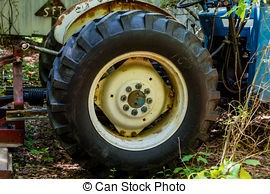
One of the biggest enemies to farm machinery and infrastructure is corrosion damage. It is clear when corrosion is present because discoloration and deformation appears on metal surfaces. If left unattended, corrosion spreads and affects nearby surfaces.
Many tractors and trucks have heavy steel which can withstand corrosion damage for quite a while, but the corrosion damage can catch you by surprise. “One manager at last month's meeting of the Technology and Maintenance Council of the American Trucking Associations reported rust-through on axle carriers, so much that axle shafts inside began seeing damage, too. This was on a tractor only a few years old. (Trucking Info)”
According to “A Review in Agricultural Industries” by Makanjuloa Oki and Paul Anawe, the agriculture sector has prevalent exposure to corrosion. Common contributors to corrosion in the agriculture industry are chemicals used in operation such as acid preservatives, fertilizers and manure. The authors cited a study that showed fertilizers containing a nitrogenous solution of ammonium nitrate and urea reacts slowly with steel, but the reaction is rapid at the welds and bolt holes. The same study noted that phosphate solutions with ammonium phosphate are less reactive toward steel because they form a phosphate passive layer that protects the underlying substrate. Every corrosion situation varies due to differences in environmental and site factors. It is important to pay attention to what factors are controllable to reduce corrosion damage.
Corrosion is not only an aesthetic issue; it has serious effects on the function and lifespan of equipment. The most serious effect corrosion has is the deterioration of metal components. Corrosion damage to metal surfaces is most likely on occur to metal surfaces that are exposed to moisture repeated. Corrosion damage from moisture can lead to holes and cracks in vital wheel parts. If left unattended, the wheel can be rendered useless. 
Corrosion damage to underside components cause the vehicle to become stiff, making it hard to steer and control. It is possible for the vehicle to falter in transit if the corrosion continues to spread.
Authors Oki and Anawe note several methods to mitigate corrosion damage. “For machinery and equipment, adequate cleaning and application of temporary corrosion protection with the use of inhibited oils and greases prior to storage in a well assessed facility is important to avoid damaging corrosion effects” (Oki) It is important for all vehicle operators to conduct inspections of machinery, especially lower areas of the vehicle. Inspections should occur more frequently than the annual required inspection, especially for operations in colder climates. It is vital for individuals to remain aware of their usage of chemicals that have corrosive effects in order to manage negative impacts.
Video provided by InstantLabs
Related Article: Everything You Need to Know About Corrosion Control
Works Cited
Berg, Tom. “Investigating Vehicles For Corrosion.” Maintenance - Trucking Info, 26 May 2009, www.truckinginfo.com/149345/investigating-vehicles-for-corrosion.
Oki, Makanjuola & Anawe, Paul. (2015). A Review of Corrosion in Agricultural Industries.
Physical Science International Journal. 5. 216-222. 10.9734/PSIJ/2015/14847.
Valdez, B., et al. “Corrosion Control in Industry.” IntechOpen, IntechOpen, 12 Dec. 2012, www.intechopen.com/books/environmental-and-industrial-corrosion-practical-and-theoretical-aspects/corrosion-control-in-industry.
“What Are the Effects of Corrosion?” Camfil, www.camfil.com/en/insights/electronics-and-optics/what-are-the-effects-of-corrosion.

